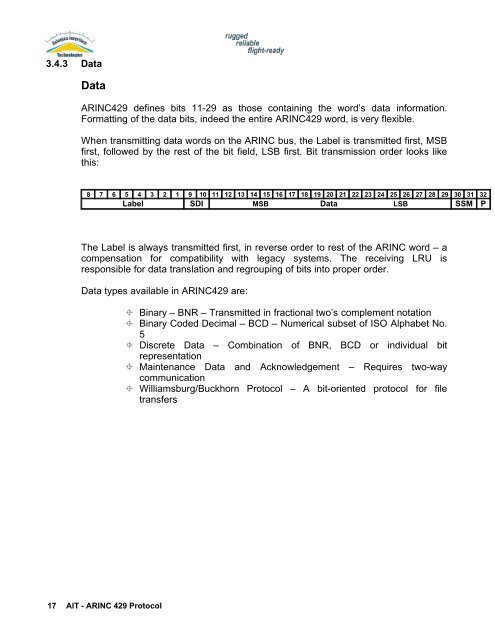ARINC429_Tutorial
ARINC429_Tutorial
ARINC429_Tutorial
You also want an ePaper? Increase the reach of your titles
YUMPU automatically turns print PDFs into web optimized ePapers that Google loves.
3.4.3 Data<br />
Data<br />
<strong>ARINC429</strong> defines bits 11-29 as those containing the word’s data information.<br />
Formatting of the data bits, indeed the entire <strong>ARINC429</strong> word, is very flexible.<br />
When transmitting data words on the ARINC bus, the Label is transmitted first, MSB<br />
first, followed by the rest of the bit field, LSB first. Bit transmission order looks like<br />
this:<br />
8 7 6 5 4 3 2 1 9 10 11 12 13 14 15 16 17 18 19 20 21 22 23 24 25 26 27 28 29 30 31 32<br />
Label SDI MSB Data LSB SSM P<br />
The Label is always transmitted first, in reverse order to rest of the ARINC word – a<br />
compensation for compatibility with legacy systems. The receiving LRU is<br />
responsible for data translation and regrouping of bits into proper order.<br />
Data types available in <strong>ARINC429</strong> are:<br />
± Binary – BNR – Transmitted in fractional two’s complement notation<br />
± Binary Coded Decimal – BCD – Numerical subset of ISO Alphabet No.<br />
5<br />
± Discrete Data – Combination of BNR, BCD or individual bit<br />
representation<br />
± Maintenance Data and Acknowledgement – Requires two-way<br />
communication<br />
± Williamsburg/Buckhorn Protocol – A bit-oriented protocol for file<br />
transfers<br />
17<br />
AIT - ARINC 429 Protocol


